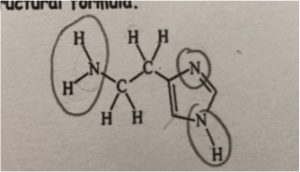1. In allergy sufferers, histamine causes runny noses, red eyes, and other symptoms. Here is its structural formula.
a. C5H9N3
b. 
c. Amine groups as they form hydrogen bonds with water.
2. Antihistamines are widely used drugs for treating symptoms of allergies caused by reactions to histamine compounds. This class of drug competes with histamine, occupying receptor sites on cells normally occupied by histamine.
a. Give the chemical formula for this compound
C16H21N3
b. What similarities do you see between this structure and that of histamine that would allow antihistamines to compete with histamine.

When you get injured or when your immune system detects a potentially dangerous foreign substance, certain white blood cells and tissue cells release histamines that seek out and attach to other cells that have a histamine receptor.
Allergies occur when your immune system erroneously thinks an innocuous foreign substance, such as pollen or pet dander, is dangerous. Histamines jump to action, causing a range of symptoms associated with allergies (sneezing, itchy eyes, chest congestion, wheezing, etc.).
Hence, antihistamines are typically used to ease allergy symptoms by competing with histamine to bind to histamine receptors, this prevents histamine from further eliciting the physiological changes, easing allergy symptoms.
3. Consider this statement. ‘Drugs can be broadly classed into two groups: those that produce a physiological response in the body and those that inhibit the growth of substances that cause infections.” Into which class does each of these drugs fall?
(a) aspirin (b) morphine (c) Keflex antibiotic (d) estrogen (e) amphetamine (f)penicillin
Produce physiological response: A, B, D, E
Inhibit growth of substances that cause infections: C, F
4. Herbal or alternative medicines are not regulated in the same way as prescription or OTC medicines. In particular, the issues of concern are identification and quantification of the active ingredient, quality control in manufacture, and side effects when the herbal remedy is used in conjunction with another alternative or prescription medicine.
a. What do you think is the evidence from herbal supplement manufacturers that address these issues?
Supported by many research studies done by TCM practitioners, the product does not contain prohibited ingredients and does not make claims to treat diseases. Packaging contains sufficient evidence and information for consumers to read when purchasing or using.
Some compounds in the products are also tested by healthcare professionals. They showed that herbal medicines do not interact with Western medicine.
b. Do you know anything about Singapore’s legislation on the topic?
They can be sold without license but dealers are advised to comply to guidelines for health/herbal supplements set by the Health Sciences Authority. For example, it should not contain any prohibited substances, claims are accurate and truthful, product label of ingredients for consumer to read and it should be printed in a clear and legible manner.
References
http://www.hsa.gov.sg/content/hsa/en/Health_Products_Regulation/Consumer_Information/Consumer_Guides/Complementary_Health_Products/Health_Supplements.html
